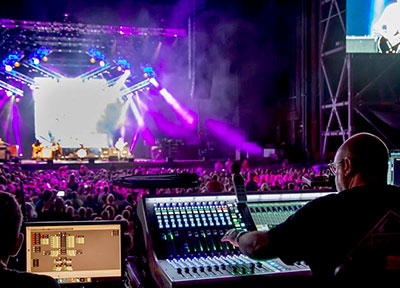Peter Frampton recently concluded his Peter Frampton Finale - The Farewell Tour, with FOH engineer Jim Yakabuski at FOH with an SSL Live L550 mixing console supplied by Solotech, Nashville.
 The tour culminated in October 2019, and was Frampton’s chance to say farewell to fans that have been coming to his shows for more than 50 years. Before the tour and reluctant to use SSL, Yakabuski favoured an analogue setup and layout but switched to the console for the tour.
The tour culminated in October 2019, and was Frampton’s chance to say farewell to fans that have been coming to his shows for more than 50 years. Before the tour and reluctant to use SSL, Yakabuski favoured an analogue setup and layout but switched to the console for the tour.
‘I wanted to hear from my colleagues that stability on the road was not an issue – and I did,’ he recalls. ‘With the tour approaching, I decided to look further into using an SSL L550 for the FOH mixer. I made some calls, and then was treated to a few hours of one-on-one instruction from SSL’s Fernando Guzman which peaked my interest. I was ready to dive in.
‘The FOH mix on this tour could easily be done on a large-format analogue console, but the previous FOH engineer and current monitor engineer decided to move it to digital for footprint reasons, and also ease of save/recall when using consoles brought in for private and one-off events,’ Yakabuski explains – adding that he did not use automation scenes for each song or many of the other ‘digital’ benefits the console boasts.
‘The key feature of the console was its sonic richness. It sounded so good, it removed the necessity to add on any external signal processing or plug-ins accessed via Madi connectivity. It became analogue mixing all over again, on a console that offered me multiple options for routing and processing, but begged to be left alone to simply sound great and blend great-sounding inputs from the stage. With each input left mostly unaffected and sent directly to the stellar-sounding summing at the master buss, all it took was pushing the faders up to hear that I didn’t have to fix the mix – just let it be.’
Yakabuski set up the console in a way that suited accessibility to key input channels and output busses to suit his personal workflow. With three tiles of 12 faders each, he managed the layers so that he was able to access any input channel or output mix from any layer on any tile.
Yakabuski’s default ‘in-show’ layout saw Tile 3 (top left) managing input Channels 1-12 for drums and bass on the first layer, with the second layer used for effects returns. Tile 2’s (bottom left) first layer handled input Channels 13-24 for guitars and vocals, the second layer managed input Channels 25-32 for keys, acoustic guitars, additional guitars and guests, while the third layer was used for playback devices and a pink noise generator, in addition for house and miscellaneous feeds. Meanwhile, Tile 1’s (bottom right) first layer handled VCA Groups 1-12, layer two was used for the speaker system’s 1-12 matrix mixes, layer three managed Stems and ‘B’ matrix mixes (record sends), while layer four was utilised for aux-sends.
‘I’m old-school this way – I still like to use auxes to send to effects and return into input channels,’ Yakabuski admits.
On the tour, all EQ and dynamics were SSL onboard-only. ‘Our daily approach always originated with tuning the entire sound system to be very consistent and optimised for the room with the same ‘flat’ transfer function response,’ Yakabuski elaborates. ‘With this palette to work with, I found that I didn’t need much in the way of channel EQ and compression to bring a channel up in the PA and have it sound great right out of the gate.
‘Some high-pass filters and small EQ tweaks was about it. Light compression was also used – emphasis on light – and noise gates were almost non-existent as the dynamic range of the band was huge: a whisper to a scream in regard to levels on drums and other instruments! I most often worked with the beautiful main display screen in Channel View mode. From there I’d do a quick double tap on the EQ section of the channel, which is my default, and I’d be in Detail View – which opened up accessibility to almost every function of channel adjustment I would need, from input and insert routing, to dynamics and panning.’
Yakabuski stresses that the sound of the L550 console is its main talking point, adding that this is the main reason most engineers switch over from their current console of choice, or think about making the switch when the right project comes their way:
‘It’s big and warm,’ he says. ‘It’s natural and uncoloured, but in a way that doesn’t feel ‘sterile’ and make you want to reach for a saturation plug-in to warm up the sound of an input. The way all the input channels sum at the Master Buss feels uncluttered and analogue, and you find that you’re hearing ‘space’ between the channels that you didn’t feel was there before with other consoles. Each channel sounds as big and round as you want it, but there’s still space between the sources. It’s really cool! And the stereo imaging is phenomenal. I think it’s the first thing I noticed when I listened to one of my favourite PA tuning tracks, and also when I started putting a mix of a live recorded show together from virtual soundcheck – panning channels in the stereo field.’
More: www.solidstatelogic.com














